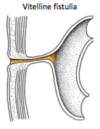GI Anatomy of Abdominal Wall Flashcards
What is the abdominal wall subdivided into?
- The anterior wall
- Right and left lateral walls
- Posterior wall
Why is the term anterolateral abdominal wall used?
Because the boundary between the anterior and lateral walls is indefinite
What is the anterolateral abdominal wall bounded by superiorly?
- The cartilages of the 7th-10th ribs
- The xiphoid process of the sternum
What is the anterolateral abdominal wall bounded by inferiorly?
- The inguinal ligament
- The superior margins of the anterolateral aspects of the pelvic girdle
What are the anterolateral aspects of the pelvic girdle?
- Iliac crests
- Pubic crests
- Pubic symphysis
What does the anterolateral abdominal wall consist of?
- Skin
- Subcutaneous tissue
- Muscles and their aponeuroses
- Deep fascia
- Extraperitoneal fat
- Parietal peritoneum
What does the subcutaneous tissue of the anterolateral abdominal wall consist of?
Superficial fasica and fat
Label this diagram

- A - Skin (cut edge)
- B - Superficial fatty layer of subcutaneous tissue (Camper fascia)
- C - Deep membranous layer of subcutaneous tissue (Scarpa fascia)
- D - Investing (deep) fascia- superficial, intermediate, and deep
- E - Parietal peritoneum
- F - Endoabdominal (transversalis) fascia
- G - Extraperiteoneal fat
- H - Transversus abdominis
- I - Internal oblique
- J - Internal oblique
What is the umbilicus?
An obvious feature of the anterolateral abdominal wall at spinal level L3
What is the epigastric fossa also known as?
Pit of the stomach
What is the epigastric fossa?
Slight depression in the epigastric region
Where is the epigastric fossa found?
Just inferior to the xiphoid process
What is the epigastric fossa particularly noticeable?
When the person is in the supine position
Why is the epigastric fossa particularly noticeable when the person is in the supine position?
Because the abdominal organs spread out
What is commonly felt on the side of the epigastric fossa?
Heartburn
What forms the linea alba?
Aponeurosis of the abdominal muscles
What does the linea alba separate?
The left and right rectus abdominis
Who is the linea alba visible in?
Lean individuals
Why is the linea alba visible in lean individuals?
Because of the vertical skin groove superficial to it
What is the name of the condition where the linea alba is lax?
Divarication of recti
What happens in divarication of recti?
When the rectus abdominis contract, the muscles spread apart
What is the pubic crest?
The upper margins of the pubic bones
What is the pubic symphysis?
The cartilaginous joints that unite the pubic bones
Where can the pubic crest be felt?
At the inferior end of the linea alba





































